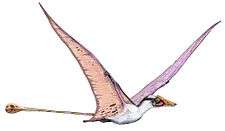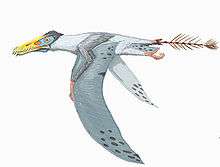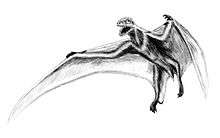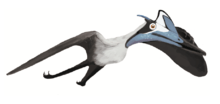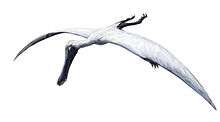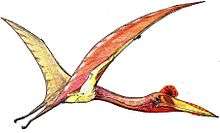Bennettazhia
Bennettazhia is a genus of pterosaur (flying reptile).
| Bennettazhia | |
|---|---|
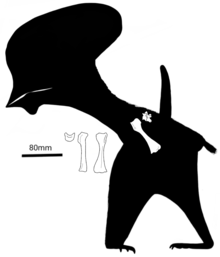 | |
| Skeletal diagram of Bennettazhia oregonensis | |
| Scientific classification | |
| Kingdom: | Animalia |
| Phylum: | Chordata |
| Order: | †Pterosauria |
| Suborder: | †Pterodactyloidea |
| Clade: | †Tapejaromorpha |
| Genus: | †Bennettazhia Nesov, 1991 |
| Type species | |
| †Pteranodon oregonensis Gilmore, 1928 | |
| Species | |
| |
| Synonyms | |
| |
In 1928, Charles Gilmore named a new species of Pteranodon: P. oregonensis. A humerus (holotype MPUC V.126713), two fused dorsal vertebrae and the broken-off end of some joint bone had been unearthed from the Lower Cretaceous (Albian) beds of the Hudspeth Formation in Wheeler County, in the state of Oregon, USA, to which the specific epithet refers. Gilmore noted similarities to Nyctosaurus though the specimens were larger.
In 1989, S. Christopher Bennett concluded that the remains might be those of a member of the Azhdarchidae instead of a pteranodontid. Russian paleontologist Lev Nesov therefore in 1991 named a new azhdarchid genus: Bennettazhia. The genus name honors Bennett and combines his name with Persian azhdarha, "dragon", a reference to Azhdarcho, the type genus of the Azhdarchidae. Bennett himself in 1994 changed his opinion and stated that it belonged to the Dsungaripteridae. Wellnhofer (1991), Peters (1997), Kellner (2003) and Unwin (2003) left it as belonging to the Pterodactyloidea incertae sedis.
In 2007, American biologist Michael Habib revealed the result of a study by CAT-scan of the type specimen. The humerus, 183 millimetres long, is uncrushed, which is uncommon for a pterosaur fossil and therefore offered a rare opportunity to investigate the bone structure. Apart from the thin bone wall, the humerus was filled with a spongy tissue consisting of trabeculae, very thin bone layers and struts, forming a light yet strong construction. Habib inferred that such strength would have allowed even very large pterosaurs to launch themselves from the ground using their forelimbs. The same investigation made a better classification possible. The humerus has an elongated deltopectoral crest that is unwarped. Both dsungaripterids and azhdarchoids show this feature, but only the latter group is typified by such a very thin outer bone wall. Habib concluded that Bennetazhia was a member of the Azhdarchoidea, a more encompassing group than the Azhdarchidae.
Classification
The cladogram below follows the 2014 analysis Andres and colleagues.[1]
| Azhdarchoidea |
| ||||||||||||||||||||||||||||||||||||||||||||||||||||||||||||||||||||||||||||||
See also
- Timeline of pterosaur research
- List of pterosaurs
References
- Andres, B.; Clark, J.; Xu, X. (2014). "The earliest pterodactyloid and the origin of the group". Current Biology. 24 (9): 1011–6. doi:10.1016/j.cub.2014.03.030. PMID 24768054.
- Gilmore C. W. (1928), "A new Pterosaurian reptile from the marine Cretaceous of Oregon", Proc. U. S. Nat. Mus. 73, art. 24, 1–5
- Bennett S. C. 1989, "Pathologies of the large pterodactyloid pterosaurs Ornithocheirus and Pteranodon", Journal of Vertebrate Paleontology, 9: 13A
- Nesov, L. A. (1991), "Gigantskiye lyetayushchiye yashchyeryi semyeistva Azhdarchidae. I. Morfologiya, sistematika", Vestnik Leningradskogo Universiteta, Seriya. 7; Geologiya, Geografiya (2), 14–23
- Bennett S. C. (1994), "Taxonomy and systematics of the Late Cretaceous pterosaur Pteranodon (Pterosauria, Pterodactyloidea)", Occ. Pap. Nat. Hist. Mus. Univ. Kansas 169
- Michael Habib (2007), "Structural characteristics of the humerus of Bennettazhia oregonensis and their implications for specimen diagnosis and azhdarchoid biomechanics", p. 16 in: Flugsaurier: The Wellnhofer pterosaur meeting, Bavarian State Collection for Palaeontology, Munich 2007, [Abstract]
